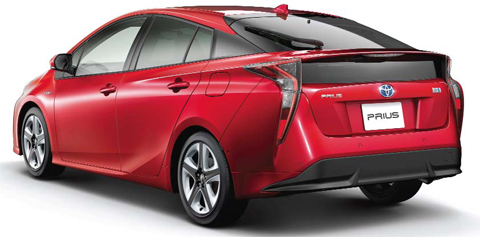 Toyota presented its vision for the future of mobility at this year's Tokyo Motor Show, where three very different new concept cars were revealed. While some of the vehicles represent the development and commercialization of groundbreaking new technologies, others seek to explore and strengthen the emotional bond between car and driver. The Tokyo Motor Show started on October 29th and concluded yesterday.
Toyota presented its vision for the future of mobility at this year's Tokyo Motor Show, where three very different new concept cars were revealed. While some of the vehicles represent the development and commercialization of groundbreaking new technologies, others seek to explore and strengthen the emotional bond between car and driver. The Tokyo Motor Show started on October 29th and concluded yesterday.
Toyota's commitment to advanced powertrain technology was represented by the all-new Prius and the Toyota FCV Plus, a fuel cell concept that embodies Toyota's vision of a sustainable society in which hydrogen energy is in widespread use.
While the above vehicles represent the ever-changing nature of mobility, Toyota also showed two concepts created to reaffirm the fundamental relationship between car and driver: the Toyota S-FR, a fun-to-drive entry-level lightweight sports car, and the Toyota KIKAI, a design concept that reminds us of the innate beauty of machinery.
According to Takayuki Yoshitsugu, Chief Representative, Middle East and North Africa Representative Office, TOYOTA Motor Corporation, "The Tokyo Motor Show is a great platform for Toyota to demonstrate its vision of how mobility is evolving while also showing our latest models including the fourth generation Prius which embodies our commitment to sustainability. We also took this opportunity to display three fascinating concept cars which offer a tantalising glimpse into an exciting automotive future where driver and machine are in harmony and advanced technology turns eco-cars into energy-cars. I would like to thank our loyal customers who have supported us over the years and believed in our bold vision and innovative initiatives aimed at setting new standards in the automotive industry."
Toyota Prius
Since its launch as the world's first mass-produced hybrid passenger vehicle in 1997, the outstanding environmental performance and advanced features of the Prius have set the stage for the growth of hybrid vehicles worldwide. Based on the pursuit of evolution truly worthy of the pioneering Prius brand, the fourth-generation model is our first global vehicle to use the Toyota New Global Architecture (TNGA), an innovative, integrated development program for powertrain components and vehicle platforms.
The new model inherits the nameplate's signature triangular silhouette which, combined with a low center of gravity, results in an impressively angular yet emotional design. A comprehensive program of size and weight reductions for major hybrid components transaxle, motor, battery, and engine has also been achieved. As a result, the Prius has achieved over 40 percent thermal efficiency and a huge boost in fuel economy.
The new Prius has also received an entirely new Toyota platform. This has resulted in improved handling, safety and heightened driving enjoyment. The model features a chassis that is 60 percent more rigid, while the powertrain unit's lower placement and low center of gravity has increased the vehicle's stability and comfort.
Toyota FCV Plus Concept (world premiere)
This concept showcases Toyota's vision of a sustainable society in which hydrogen energy is in widespread use. In addition to the vehicle's own hydrogen tank, the car can also generate electricity directly from hydrogen stored outside the vehicle. The vehicle can thus be transformed into a stable source of electric power for use at home or away. When the car is not being used as a means of transport, it shares its power generation capabilities with communities as part of the local infrastructure.
Toyota KIKAI Concept (world premiere)
The concept was designed to explore and emphasize the fundamental appeal of machines: their fine craftsmanship, their beauty, simplicity, and their fascinating motion. This concept takes the machinery, normally hidden beneath the vehicle body, and makes an open display of its beauty. The small window at the driver's feet is another distinctive aspect of this car's structure, communicating the movements of the tires and suspension and the rush of speed along the road surface. Through the windshield, the movements of the upper control arm are also visible. This provides a novel driving sensation in which the machinery that supports the operations of cruising, turning, and stopping in ordinary everyday driving can be directly perceived with the senses. The adoption of a central driver seat, which places the driver at the heart of the car, gives a more instinctive sensory connection with the vehicle.
Toyota S-FR Concept (world premiere)
The Toyota S-FR is a concept vehicle that continues the proud heritage of Toyota's fun-to-drive lightweight sports cars. Pitched as an entry-level model, the new concept emphasizes responsiveness, and aims to make a whole new generation fall in love with driving. The concept's compact body is incredibly light, yet offers a smooth driving style. Benefiting from the unique advantages of a lightweight sports car, the concept offers smooth, responsive and direct handling that gives a real sense of communication between car and driver one key benefit of the FR (front engine/rear drive) format. The concept's long nose and wide stance make for an archetypal sports car profile, while the familiar roundness of its frame inspires a feeling of closeness. The simple and modern finish of the interior rounds off a design that stresses approachable simplicity while conveying the vehicle's performance and sporty spirit.










